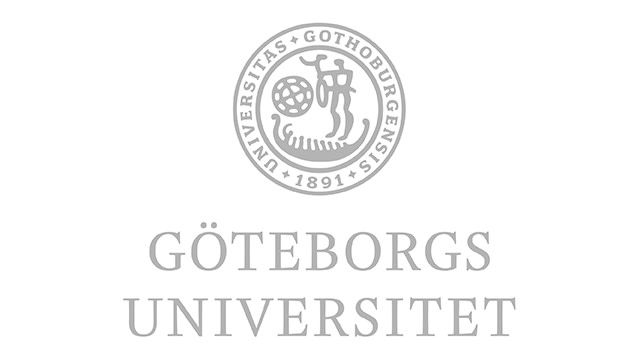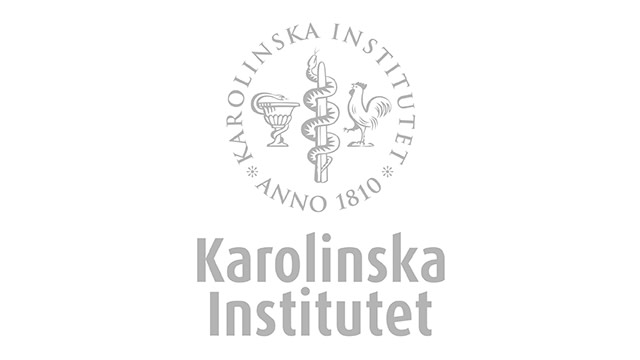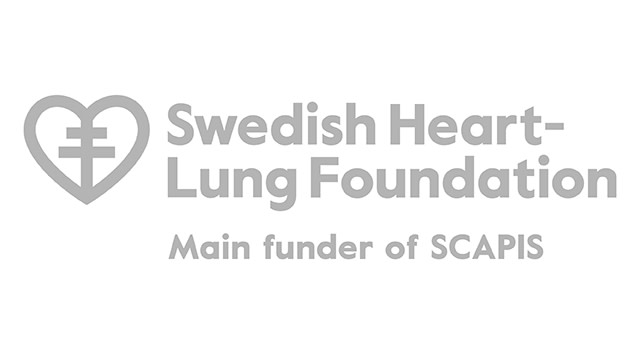About the SCAPIS study
The aim of the Swedish CArdioPulmonary bioImage Study (SCAPIS) is to predict and prevent cardiovascular disease (CVD) and COPD.
SCAPIS will provide a nationwide, open-access, population-based cohort for the study of cardiovascular disease (CVD) and chronic obstructive pulmonary disease (COPD). SCAPIS has recruited 30,154 men and women aged 50 to 64 years with detailed imaging and functional analyses of the cardiovascular and pulmonary systems. The data were collected at six university hospitals in Sweden (Uppsala, Umeå, Linköping, Malmö/Lund, Gothenburg and Stockholm). Biobanked blood and DNA will be analysed in collaboration with SciLifeLab.
The risk factor patterns for myocardial infarction (MI), stroke and COPD have changed dramatically during the last two decades, from an environment with high levels of cholesterol, blood pressure and smoking, to a scenario dominated by obesity, hypertriglyceridemia and diabetes.
The same era has seen an unparalleled development of imaging and proteomics/metabolomics/genomics (“-omics”) technologies. As a consequence, strategies for diagnosis and prevention of cardiopulmonary diseases developed just a few decades ago lack evidence and perhaps also relevance in today’s healthcare. These strategies have the potential to be dramatically improved by using recently developed advanced imaging techniques that allow us to directly image the disease process rather than relying on the limited information provided by indirect risk factors, and by using recent developments in large-scale -omics techniques, facilitating the identification of new biomarkers and mechanisms for disease. The only way to bridge this knowledge gap is to assemble a new large cohort study including examinations using the most recent and most promising techniques.
• To use advanced imaging technologies of atherosclerosis in the coronary and carotid arteries together with information obtained by proteomics/metabolomics/genomics technologies to improve risk prediction for cardiovascular disease. The clinical implications would be better-targeted intensive risk factor interventions, which will save both lives and medical costs.
• To improve the understanding of underlying mechanisms of disease in CVD and COPD. An example is the use of detailed metabolic imaging with computed tomography (CT) to elucidate the links between fat deposition patterns and risk of subclinical atherosclerosis and the development of CVD in persons with and without COPD. This could lead to the discovery of new treatment targets and preventive strategies.
• To improve the understanding of the epidemiology of CVD and COPD. An example is investigating why high morbidity and mortality rates from CVD and COPD persist in individuals with low socioeconomic status, despite an overall reduction in mortality from CVD and a levelling of age-adjusted mortality for COPD. This could lead to the improved care of COPD patients to prevent CVD, and better-targeted intervention in persons with a low socioeconomic status.
• To evaluate the cost-effectiveness of using new imaging techniques and modern -omics technologies to target preventive efforts against CVD and COPD.
The SCAPIS study is led by the National Steering Committee comprises representatives of the participating universities. An International Advisory Board is connected to The National Steering Committee.
The SCAPIS office opened in March 2021 with the purpose of being the contact point for researchers, study participants and members of the public seeking general information about the study or who are interested in using the SCAPIS resources in research. The SCAPIS office also manage the sharing of data, bioimages and blood samples for researchers as well as taking part in the development of the SCAPIS data base.
SCAPIS National Steering Committee
The National Steering Committee comprises representatives from all study centres endorsed by the universities and include experts in cardiology, pulmonary medicine, radiology and ethics.
Professor Göran Bergström, Director, University of Gothenburg (PI Gothenburg)
Professor Carl Johan Östgren, vice Director, Linköping University (PI Linköping)
Professor Anders Blomberg, Umeå University (PI Umeå)
Professor Carl-Johan Carlhäll, Linköping University (Co-PI Linköping)
Professor Gunnar Engström, Lund University (PI Malmö/Lund)
Professor Emil Hagström, Uppsala University, (Co-PI Uppsala)
Professor Tomas Jernberg, Karolinska Institute (PI Stockholm)
Professor Lars Lind, Uppsala University (Co-PI Uppsala)
Professor Andrei Malinovschi, Uppsala University (PI Uppsala)
Associated Professor Margaretha Persson, Lund University (Co-PI Malmö/Lund)
Professor Annika Rosengren, University of Gothenburg (Co-PI Gothenburg)
Professor Magnus Sköld, Karolinska Institute (Co-PI Stockholm)
Professor Stefan Söderberg, Umeå University (Co-PI Umeå)
International Scientific Advisory Board
Professor Per Bakke, University of Bergen, Norway
Professor Robert Clarke, University of Oxford, UK
Professor Marc Dewey, Radiology Institute at Charité University of Medicine, Berlin, GE
Professor Kay-Tee Khaw, University of Cambridge, UK
Professor Juhani Knuuti, Turku PET Centre, Turku University Hospital, Turku, FI
Professor Eva Prescott, University of Copenhagen and Bispebjerg University Hospital, Copenhagen, DK
SCAPIS office
Eva Karin Anderberg, Manager
Charlotte Benninge, Administrative Coordinator
Charlotte Brage, Project Manager
Anna Frick, Project Manager
Julie Johannesson, Administrative Officer
Rebecca Josefson, Scientific Coordinator
Theodor Lewén, Technical Project Manager
Louise Rundqvist, Administrative Officer
Funding
The Swedish Heart and Lung Foundation is the main funder of SCAPIS. Considerable support was also given by Knut and Alice Wallenberg Foundation, Vinnova, The Swedish Research Council and the participating Universities (Uppsala University, Umeå University, Linköping University, Lund University and University of Gothenburg and Karolinska Institute) and University Hospitals (Uppsala University Hospital, University Hospital of Umeå, Linköping University Hospital, Skåne University Hospital, Sahlgrenska University Hospital and Karolinska University Hospital).
Detailed information on the design of the SCAPIS study has been described by G Bergström et al in J Intern Med 2015.
In short, SCAPIS has recruited 30,154 randomly selected men and women aged 50 to 64 years. The recruitment and examinations were performed at six university hospitals (Uppsala, Umeå, Linköping, Malmö/Lund, Gothenburg and Stockholm). The study examinations were performed on two to three separate days separated by one to two weeks and divided into:
Core examinations – collected at all sites
Questionnaire – The questionnaire uses a total of 150 questions separated in validated sets relating to dimensions central to the research aims. Detailed information on diet, environmental and lifestyle factors as well as data on psychosocial well-being, socioeconomic status and other social determinants are collected.
Anthropometry, ECG, blood pressure and physical activity – Standard anthropometric data as well as blood pressure and ECG measurements are collected. Physical activity is measured by accelerometer testing for seven days.
Imaging and functional tests relating to the cardiovascular system – To assess the status of the three major vascular beds involved in cerebral, cardiac and peripheral artery disease, we use CT angiography for coronary disease, ultrasound and magnetic resonance imaging (MRI) for carotid disease and ankle-brachial index for peripheral artery disease.
The coronary circulation is assessed directly with CT angiography using contrast injection and high-frequency imaging (Motoyama, JACC 2009). We also measure the calcium content in each coronary artery. CT angiography is extremely powerful and gives information on morphology of calcified and non-calcified plaques and their lumen obstruction, as well as remodelling of lumen geometry. Thus, CT angiography provides information that could not be obtained by conventional intra-arterial angiography.
Ultrasound is the best validated non-invasive technique to detect, quantify and stage subclinical atherosclerosis in the carotid arteries (Mathiesen, Circulation 2001; Spence, Nat Clin Pract Neurol 2006). In addition to plaque size and number, the grey-scale of the 2D plaque image and its distribution can be used to differentiate homogenous vs. heterogeneous structures and low vs. high echogenicity. Patients with moderate to large plaques in their carotid arteries are asked to participate in a third visit for an MRI to get in-depth information on plaque inflammation, lipid-rich necrotic core, thick fibrous cap, intra-plaque haemorrhage, and plaque volume (Corti, Euro Heart J 2011).
Imaging and function tests relating to the lung – Early structural changes in lung tissue are imaged using a high-resolution CT scan over the full lung volume (Heussel, Eur Radiol 2009). This provides information on airway wall thickness and emphysema and thereby essential information in the phenotyping of COPD.
Dynamic spirometry is used according to the protocol of the BOLD study to measure forced expiratory volume and forced vital capacity, and also includes a slow vital capacity manoeuvre (Buist, Lancet 2007.). Spirometry is performed 15 minutes after the subjects have inhaled 400 μg of salbutamol. Carbon monoxide diffusion capacity is also measured.
Imaging tests relating to metabolism – One of the unique strengths of SCAPIS is that it combines vascular and lung imaging with CT imaging of epicardial, intra-abdominal, intramuscular and intrahepatic fat deposits (Kullberg, Int J Obes 2007). In addition, the liver will be imaged using dual-energy CT; this approach allows us to identify excess iron stores in the liver, which is a sign of steatosis (Deugnier, World J Gastroenterol 2007).
Blood sample – A 100 ml venous blood sample is collected from each participant in the fasting state. Immediate analyses of cholesterol, HDL, LDL, triglycerides, glucose, HbA1c, hsCRP and creatinine are carried out. Remaining blood is biobanked for future analyses.
Additional examinations – performed at one or more sites
In addition to the core examinations, all sites expanded on their own research interests by adding additional examinations.
Follow-up and use of National populations registries
The SCAPIS database will be enriched with detailed, unbiased information for years to come, by linking the database with Swedish population registries. Endpoints (myocardial infarction or cardiac interventions, stroke and exacerbation of COPD) will be identified annually by linking the unique Swedish personal identification numbers to the Swedish National Hospital Discharge Register and the Swedish Cause of Death Register and other national registers such as the Pharmaceutical Register of Prescribed Drugs. The external and internal validity of these registers are high (Ludvigsson, BMC Public Health 2011). Data from national quality registers (e.g. SWEDEHEART, Riks-STROKE) will be used to retreive more detailed information on the type of event and interventions used.
Ethical considerations and approval by authorities
SCAPIS has been evaluated and approved by the ethics committee as a multi-centre study (Umeå, February 21, 2011). The local radiation committees approve the use of radiation. In addition to these formal approvals SCAPIS strives to broaden the knowledge of ethical aspects of performing large scale epidemiological studies with detailed phenotyping. SCAPIS has therefore initiated a scientific programme addressing these issues.












